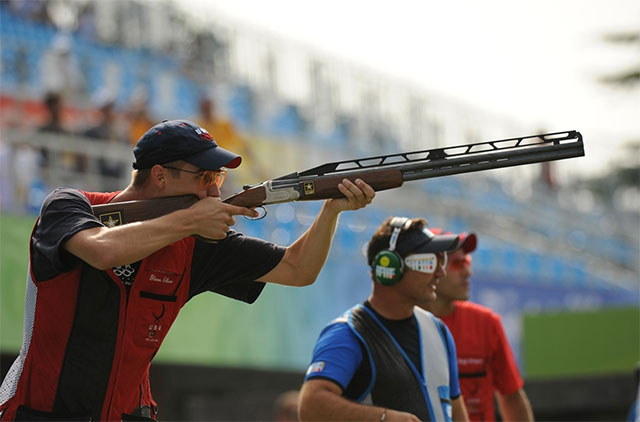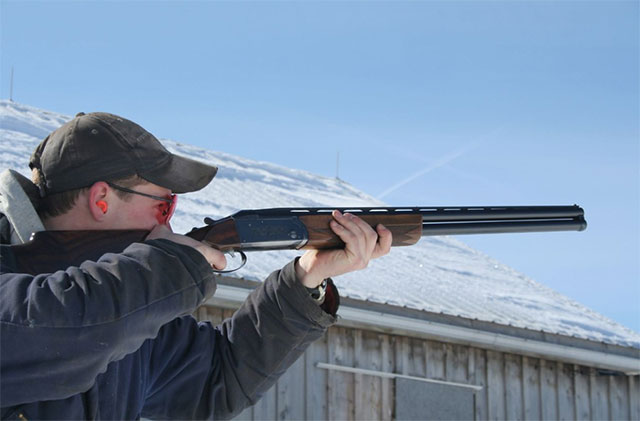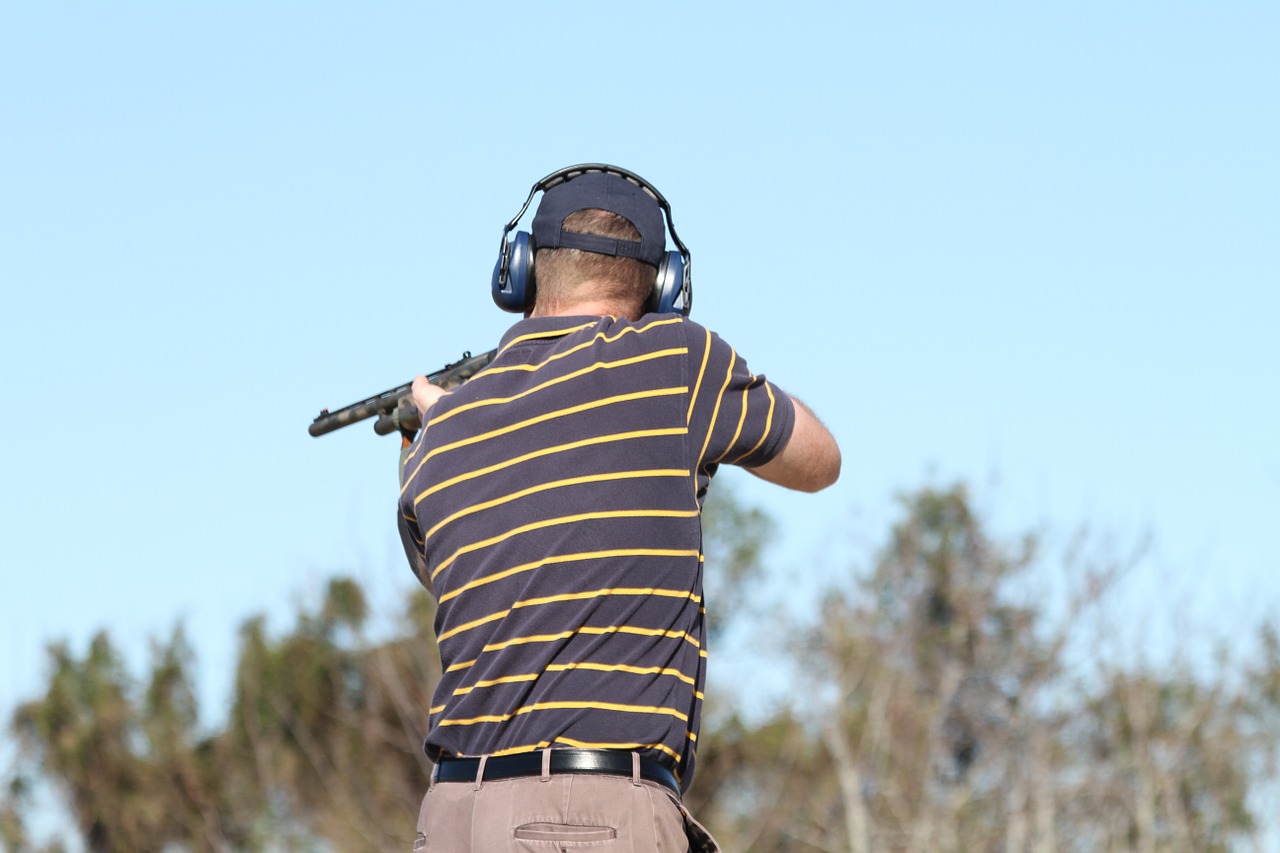If you own a shotgun, you might as well learn how to really use it. There’s no use in letting it collect dust, right?
*This post may contain affiliate links. As an Amazon Associate we earn from qualifying purchases.
Or maybe you’ve always been more of a handgun person and want to expand your scope of interest and skill set to include shotguns.
Either way, skeet shooting is a great sport to improve your hand-eye coordination and familiarize yourself with valuable shooting techniques.
Although skeet is an extremely popular sport, it’s not exactly easy pick up if you have no idea what you’re doing (or where you’re going). Here’s everything you need to know so you can hone your skills without looking like a fool.
The Interesting History of Skeet Shooting

Source: Pexels
Skeet is as American as apple pie and McDonald’s. Unlike McDonald’s and apple pie, however, shooting skeet won’t drag down your health in any way (so long as you take safety precautions, of course).In 1920, Andover bird hunters wanted a better method for developing their wingshooting skills. They needed something that mimicked the crossing flight of a live bird.
And so, skeet shooting was born.
Well, it was actually called “shooting around the clock” back then. Shooters would rotate around a 50-yard diameter circle stopping at each of the 12 stations and taking two shots at each station.
Everything went great until someone moved a flock of chickens to the opposite side of a fence near the “clock” setup. Instead of finding somewhere new to shoot, the hunters simply set up a second trap to shoot opposite the first trap.
This genius move cut the circle in half while providing the same shot opportunities – and the modern version of skeet shooting was born.
Well, almost. At this point, the hunters developed a concrete set of rules and started teaching others how to practice and shot competitively. It wasn’t until 1926 when National Sportsman and Hunting and Fishing magazines debuted the sport to the public.
But they still needed a name. Gertrude Hurlbutt won $100 in a contest for submitting the name “skeet” which is Scandinavian for “shoot.” From there, skeet shooting took off into the competitive sport we’re familiar with today.
How to Shoot in Skeet Shooting
With modern skeet shooting, you’ll move through 7 different stations.
There are two traps: one low and one high which launch clay targets called birds or pigeons in an X shape. You’ll take multiple shots at each station for a total of 25 shots per session.
You’ll need to pivot back and forth to shoot the second or third shot. As you move around the semi-circle, you’ll notice that you’re practicing shots at varying angles. The set is designed so you can practice shooting birds in flight from every position possible.
The number of clay birds shot at each station depends on the type of game you’re shooting. Beginners can stick with single or double shots while pros will take multiple shots at each station.
The clay bird travels 45 mph at an average skeet shooting course. Meanwhile, Olympic shooters take on birds traveling a whopping 62 mph. So yeah, speed of the clay bird matters.
Tips for Crafting Your Skeet Shooting Skills

Image from CC BY-SA 2.0, by Ryan Johnson, via Flickr
Like most skills, skeet takes a lot of patience and practice to develop. Sure, some people might have a natural talent for it, but those folks are few and far between – especially if they’ve never picked up a shotgun before.
If you aren’t a patient person, that’s okay because skeet can help you develop patience.
Keep these tips from pros in mind before you even hit the range:
- It’s the movement, not the accuracy. A lot of newbies try to focus on accurately hitting the bird when they should be focusing on their pivoting movement in between shots. Learn how to develop a rhythm and the shots will come naturally.
- Start with dry firing. No one will look down on you for it. Everyone needs to start somewhere and dry firing your shotgun will give you a chance to focus on your rhythm instead of the actual shot.
- Get comfortable. It can’t be stressed enough that you should buy your own gun. This will give you a chance to really get familiar with the specific gun’s recoil, loading, weight, and trigger. When you get comfortable with your shotgun it will start to feel like an extension of your body and be much easier to control.
- Pattern your gun. This alone will give you an edge over many other shooters. It’s impossible to know where your shot is landing without patterning your shot. Use a piece of paper at multiple intervals to see how your shot spreads.
What is the Difference Between Trap and Skeet Shooting?
In some ways, trap and skeet are extremely similar: they’re both competitive shooting games, they both involve a shotgun, and they both hone bird hunting skills.
Despite all the overlap, even a newbie onlooker can immediately identify the difference between shoot and trap. Skeet involves practicing your shooting skills on targets moving side-to-side. Trap, on the other hand, allows you to practice hitting targets moving away from you.
Where skeet has seven stations, trap only has five. Like skeet, however, you’ll still rotate through the different stations to practice shooting at multiple angles.
With skeet, a group of shooters (or squad if you want to get technical) will move together as a group through all seven stations. With trap, one shooter stands at each station. Each shooter individually takes their shot and they rotate through until everyone has shot five shots at that station and then they move right to the next station. The game ends after everyone has taken a total of 25 shots by cycling through the stations five times.
While skeet shooting hones your skills for flying birds, trap hones your skills for birds like grouse and pheasant.
Choosing the Right Shotgun for Skeet Shooting
There isn’t any one right or wrong answer here. The most important thing is that you find a shotgun that you feel comfortable with – everything else will come naturally as you develop your form.
As a beginner, you’ll probably want to start with an over-under shotgun for skeet shooting. Side-by-sides are generally a good choice for trap.
Not only will you be able to shoot both double and single target stations, but you’ll also get the added choke from the double barrel. This isn’t a huge concern for skeet, but you might also want to shoot trap and sporting clays, so you should just get a double-barrel you can use for a variety of activities.
If you aren’t sure what to get, you should know that you have a few different choices:
- Over-Under: This is the most common type of shotgun used for skeet shooting. It’s a double-barrel gun with the barrels sitting on top of one another rather than side-by-side.
- Side-by-Side: A side-by-side is a double-barrel shotgun with the barrels straddled – you guessed it – side by side.
- Semi-Auto: Semi-auto features aren’t just for rifles. This type of shotgun features a single barrel but loads shells automatically using a magazine rather than by hand manually.
- Pump-Action: These shotguns are more popular in the US than other countries. Otherwise known as a “slide-action” gun, a pump-action shotgun has a single barrel but can reload faster than bolt-action options. Simply pump to eject the spent shell and reload.
Still not sure? Or maybe our list made your decision even harder? Even the experts are torn on which shotgun is just the right choice for skeet. Like most things, everyone’s got an opinion and it’s usually based on personal tastes.
The main concern is that you use a shotgun rather than a rifle because it sprays shot instead of single bullets. (Good luck hitting a clay bird moving 45 mph through the air with a single bullet from a rifle.)
Safety is another big concern. Both skeet and trap are completed in groups. Shotguns make it easy to physically see from a reasonable distance whether or not someone’s gun is loaded.
Which brings us to another point: always walk around the range with your shotgun open and the barrel pointed down.
Finding Somewhere Perfect to Shoot

If you’re interested in learning how or where to shoot, the National Skeet Shooting Association will become your new best friend. Their website provides a nice search feature for finding clubs in your area – and most states have several.
Keep in mind that many clubs might require private membership fees to join and shoot on a regular basis. If you’re really serious about skeet shooting, you can make a commitment to shoot on a weekly, bi-weekly, or monthly basis with your home club. You can also participate in state, regional, and national competitions.
Don’t feel overwhelmed if that sounds like things are moving too fast. You can always inquire within the club about training or open shoot days for non-members.
Everyone needs to start somewhere and the shooting community takes the sport very seriously so no one will look down on you for not understanding something – they’ll want to help.
Now it’s time to pick your gun and find a club – happy shooting!